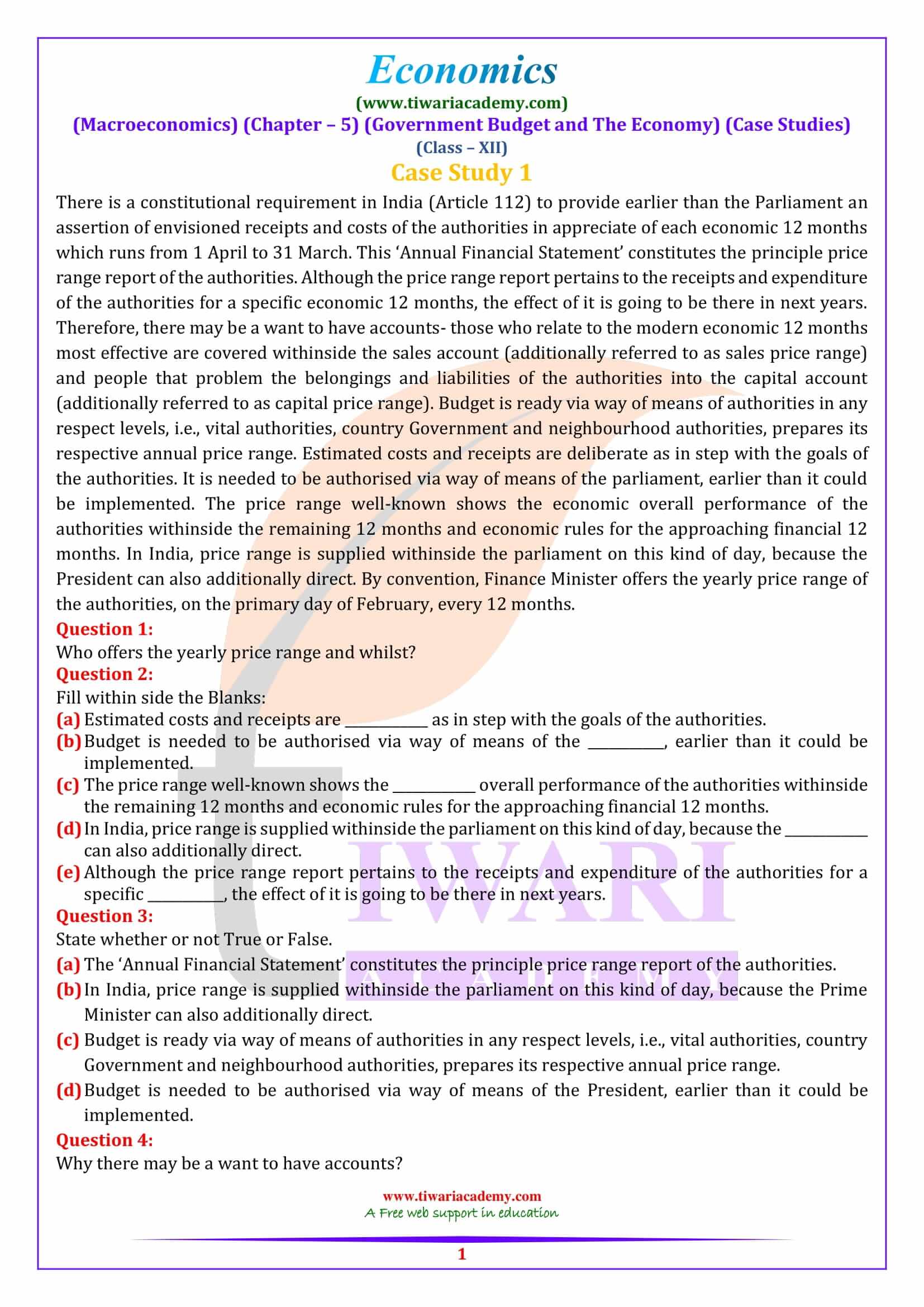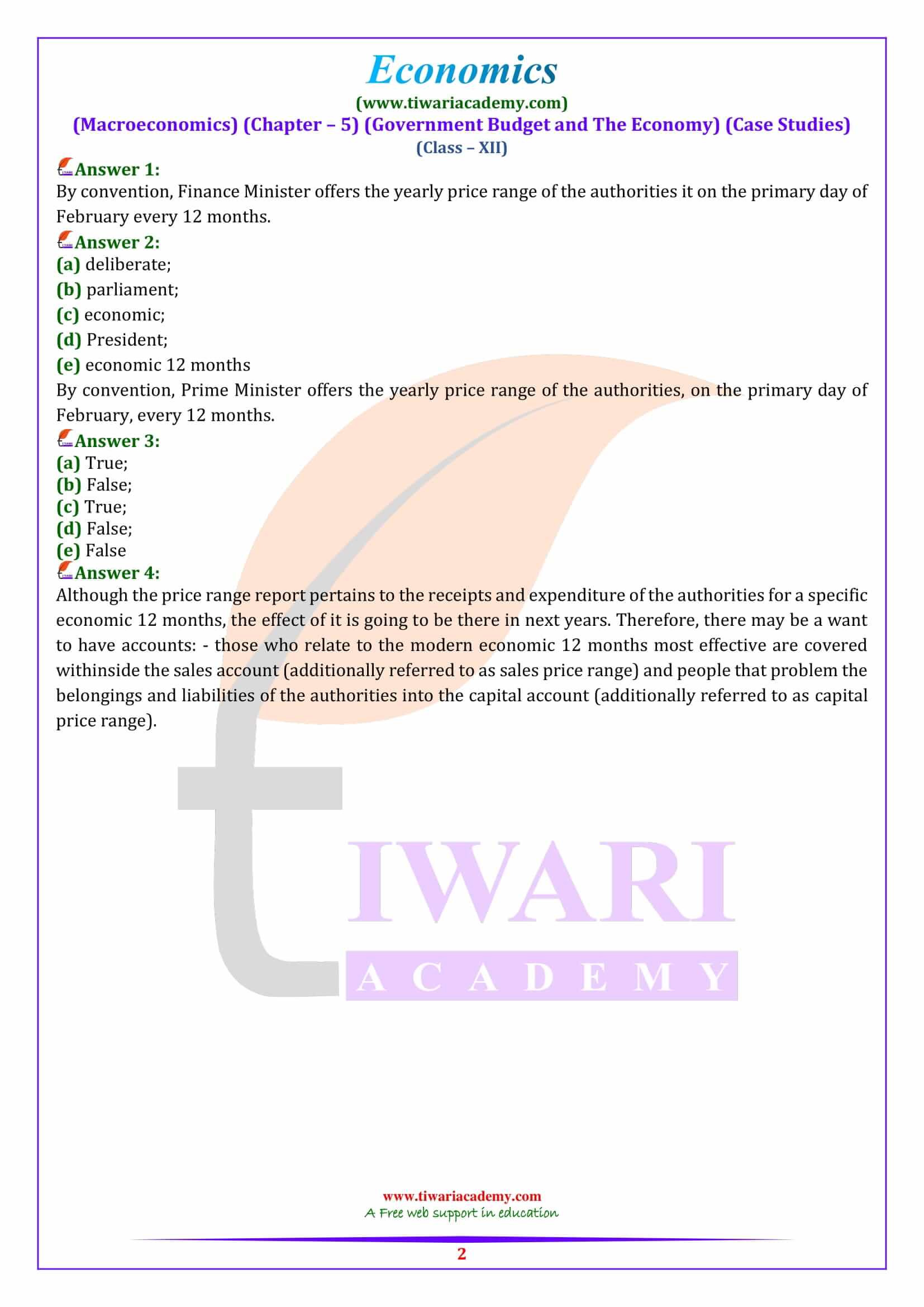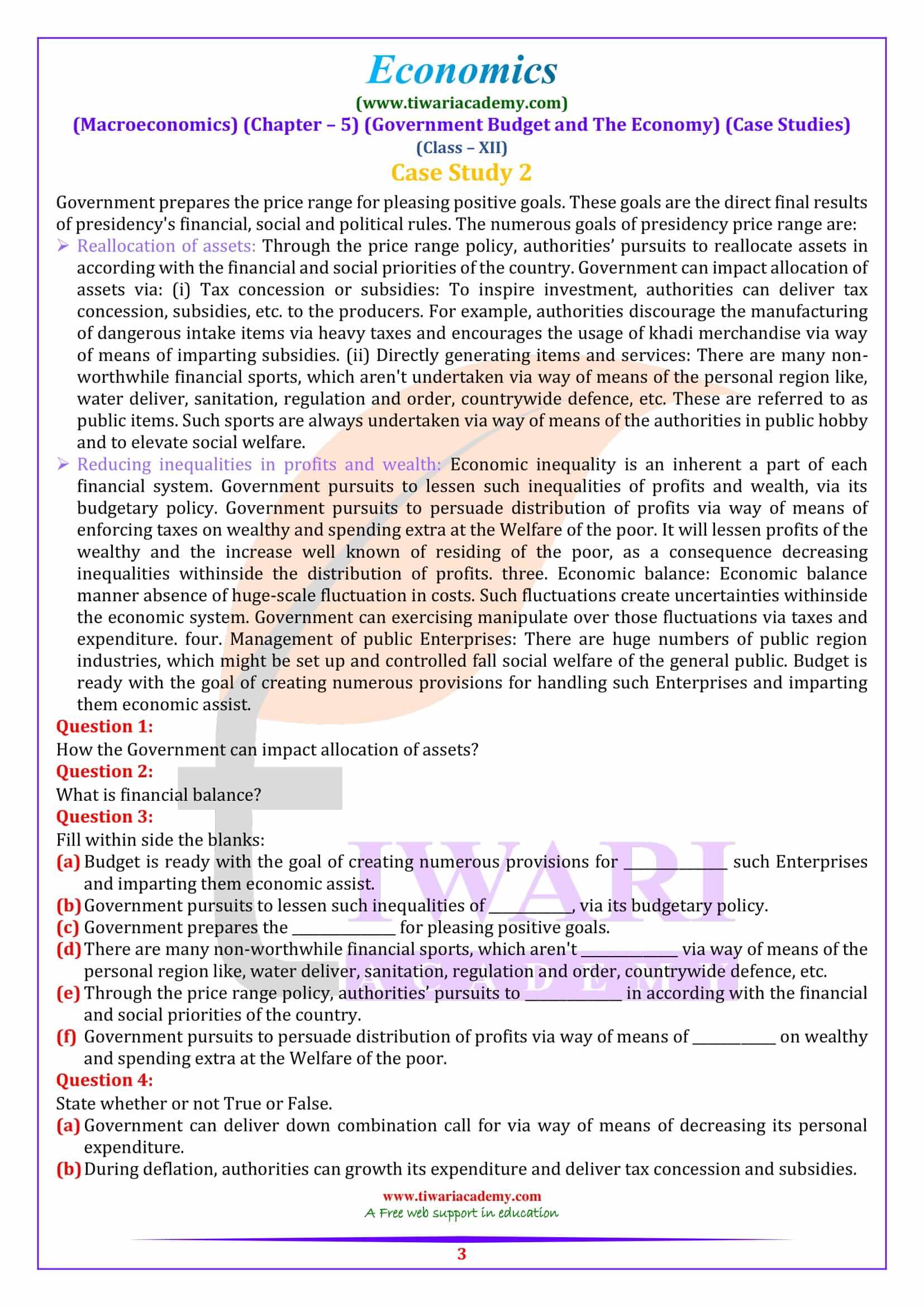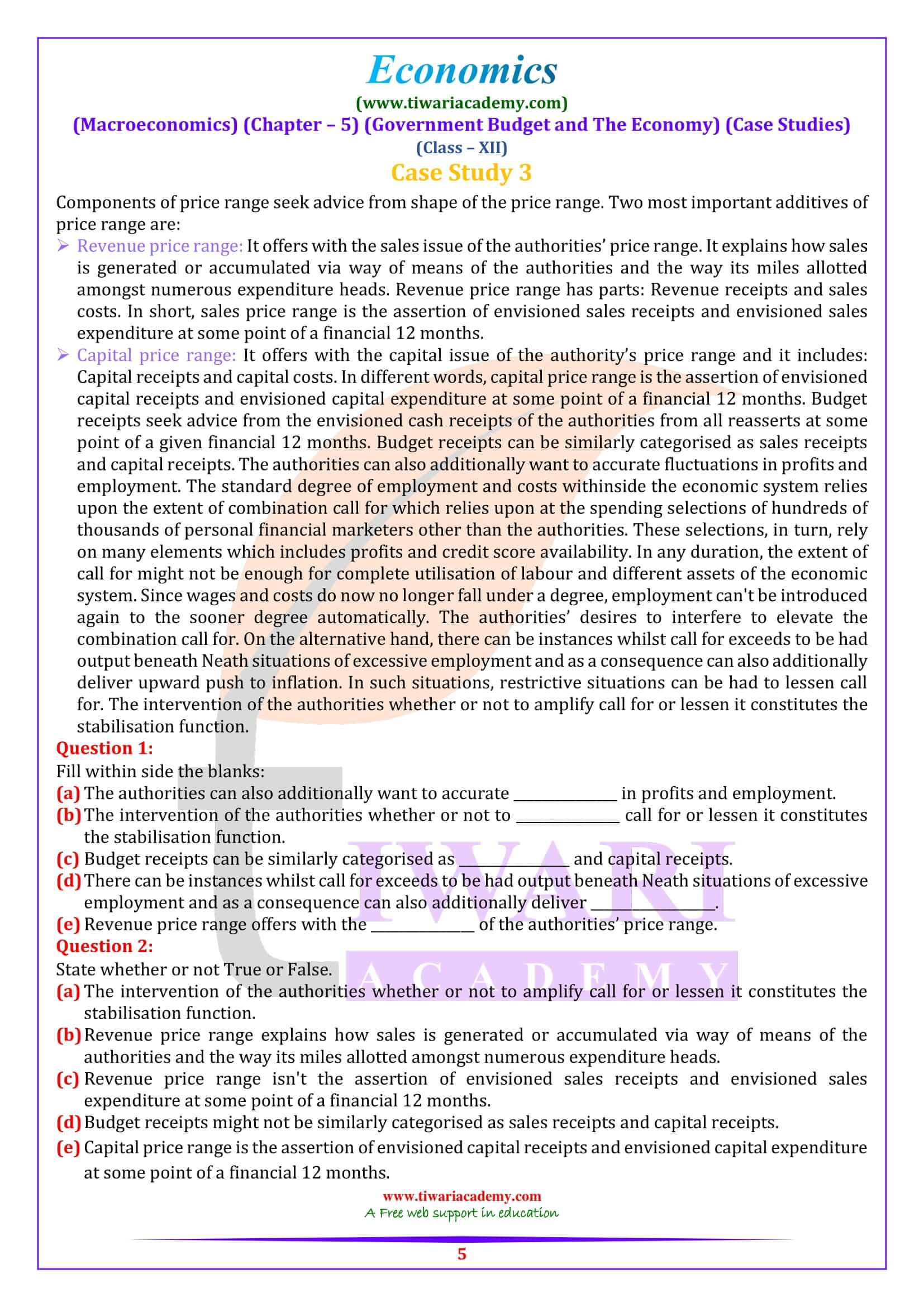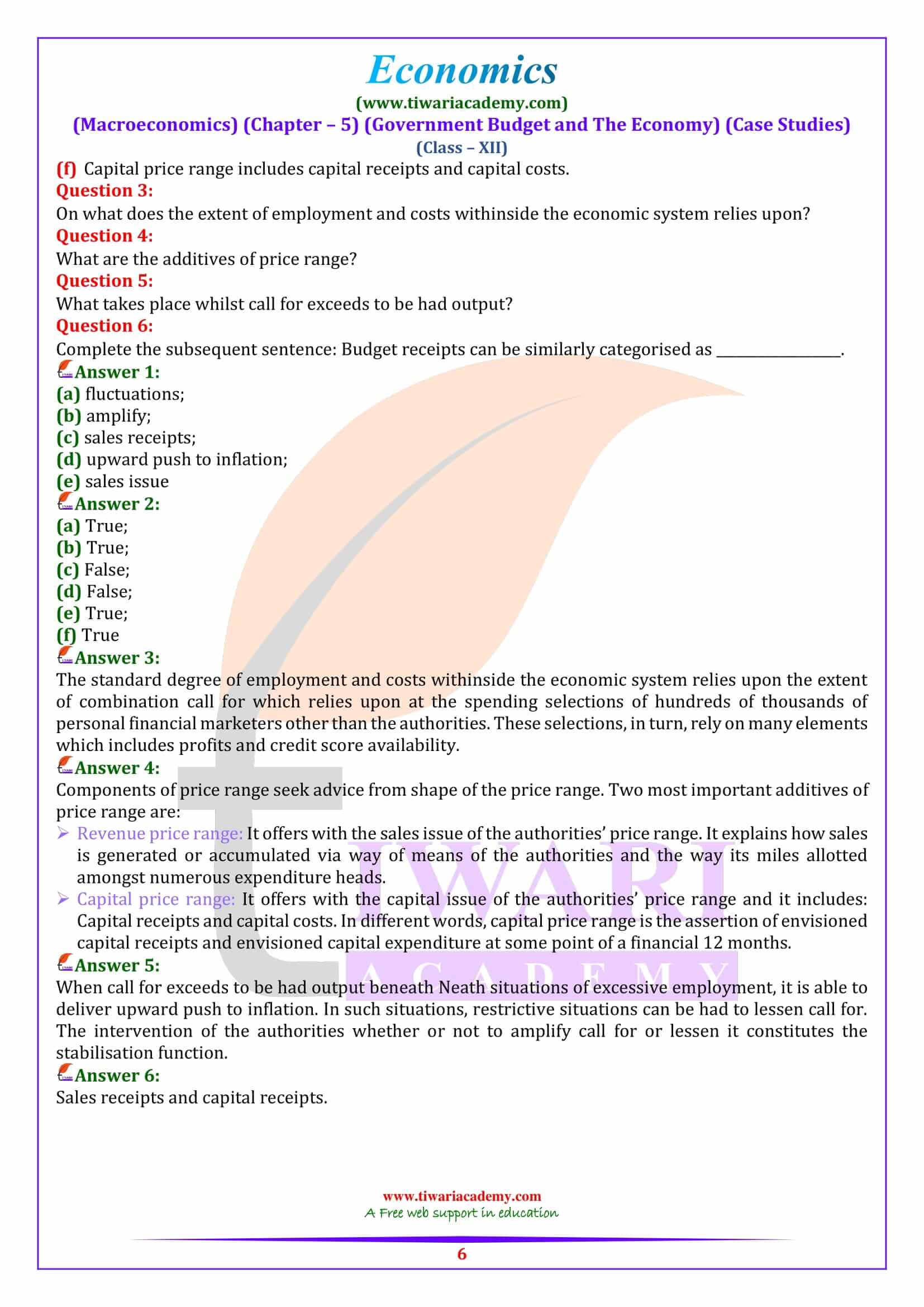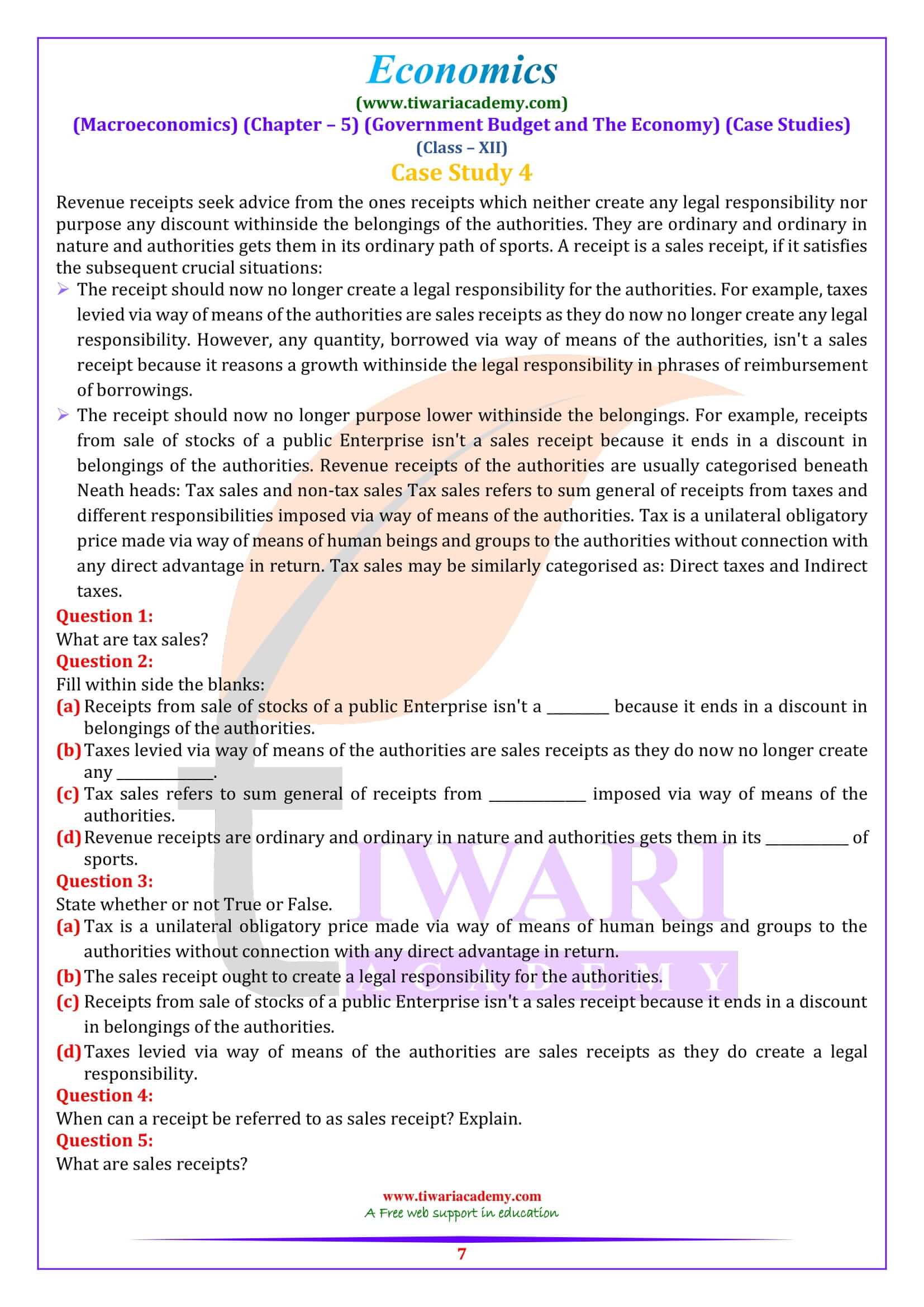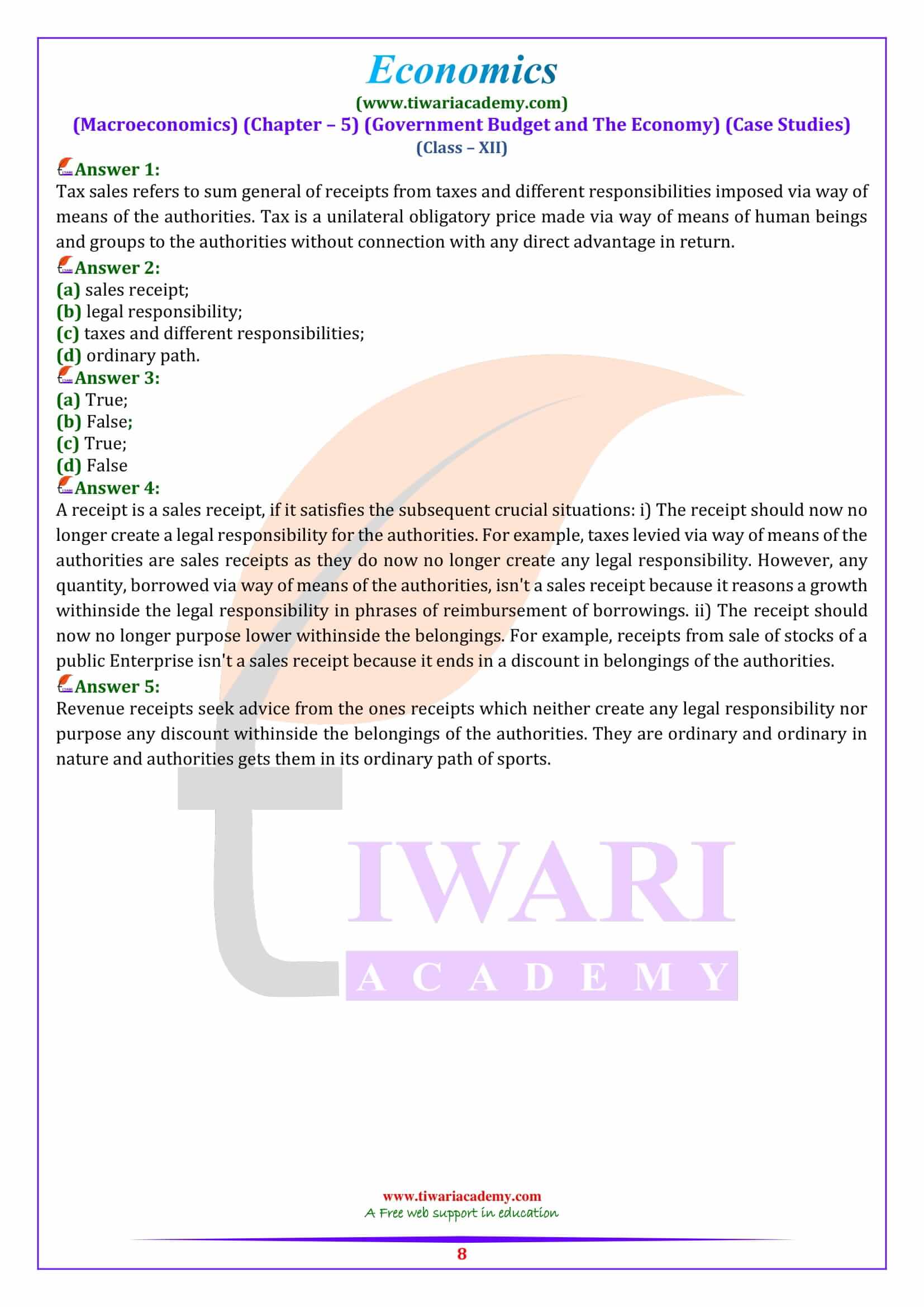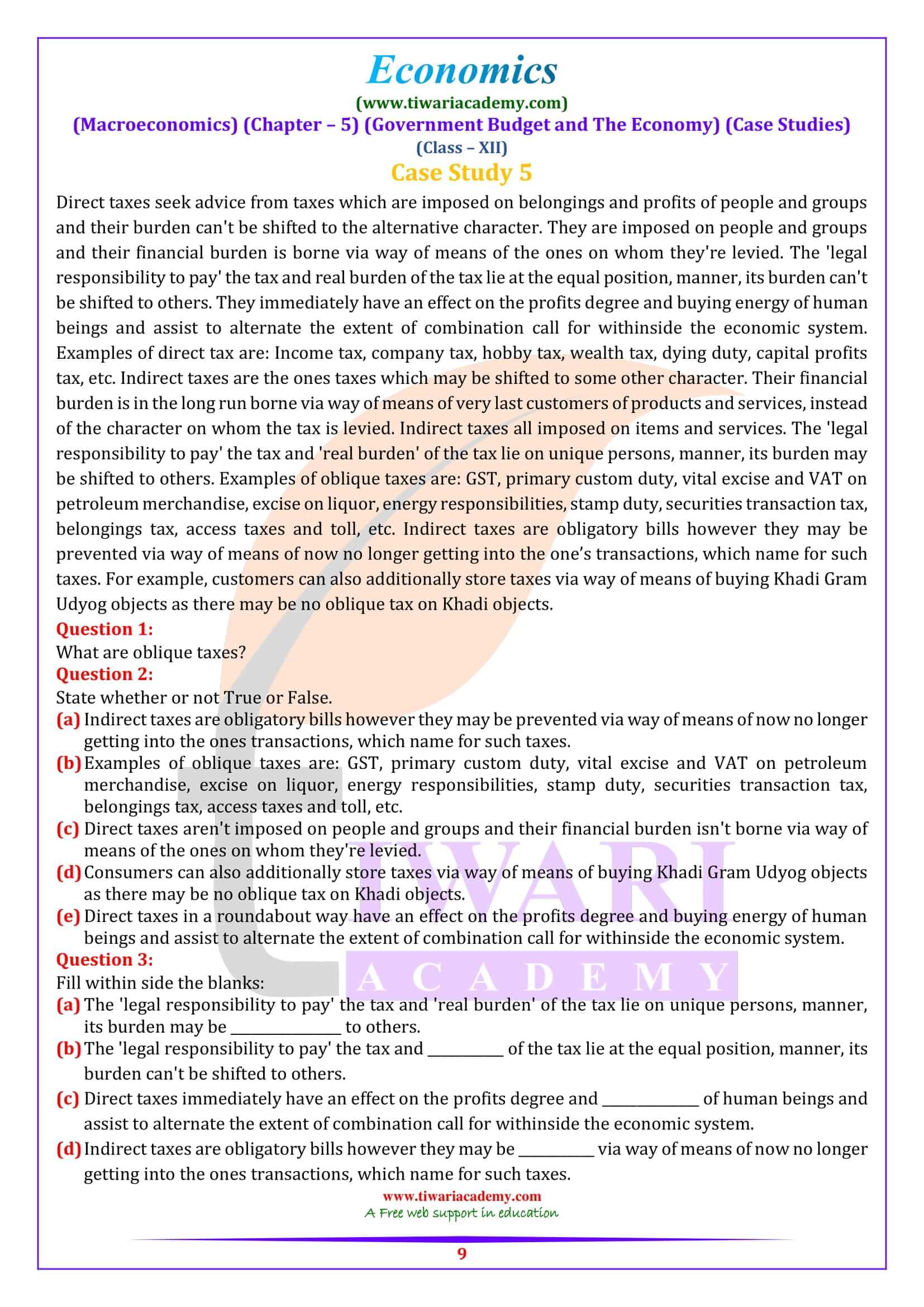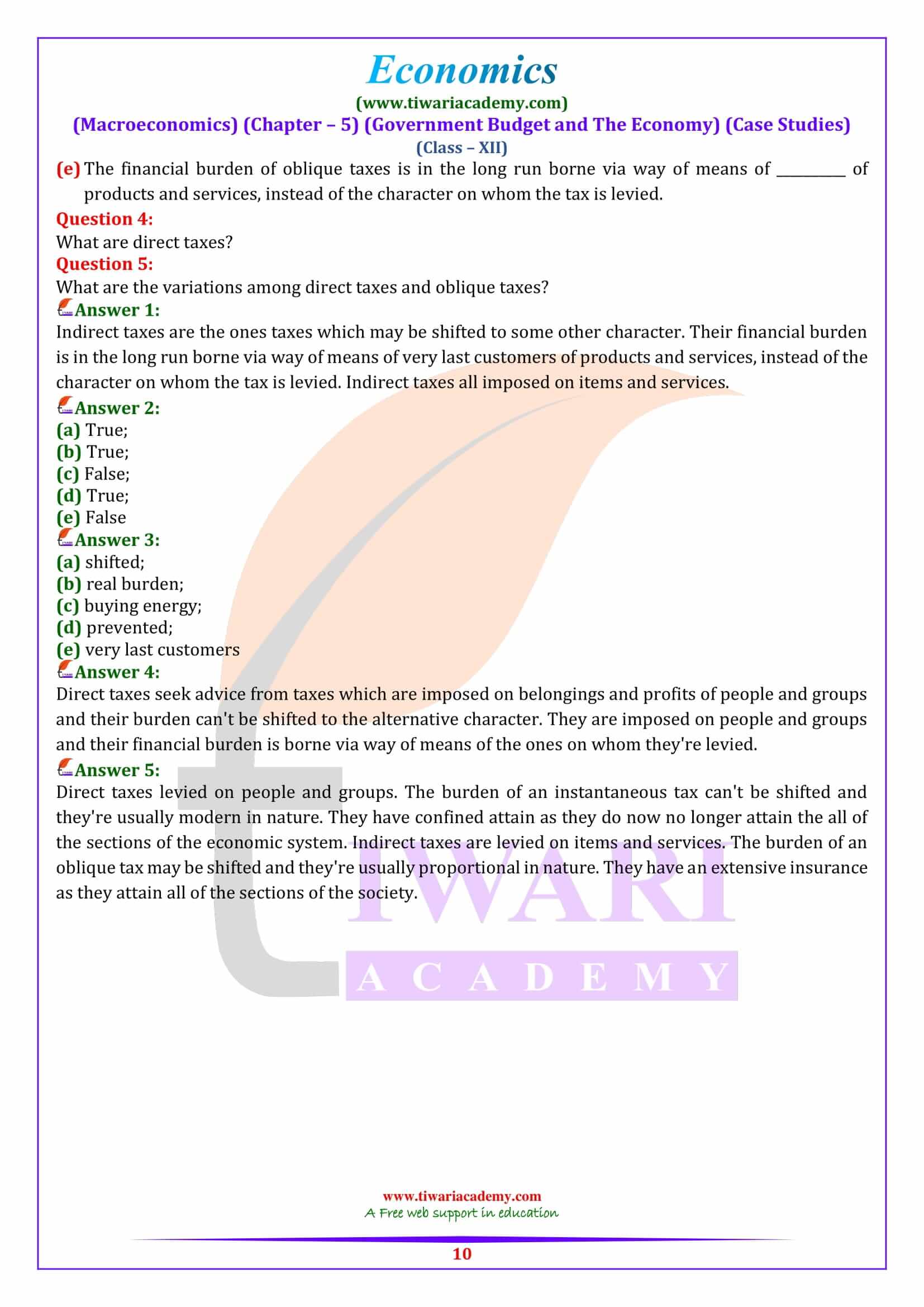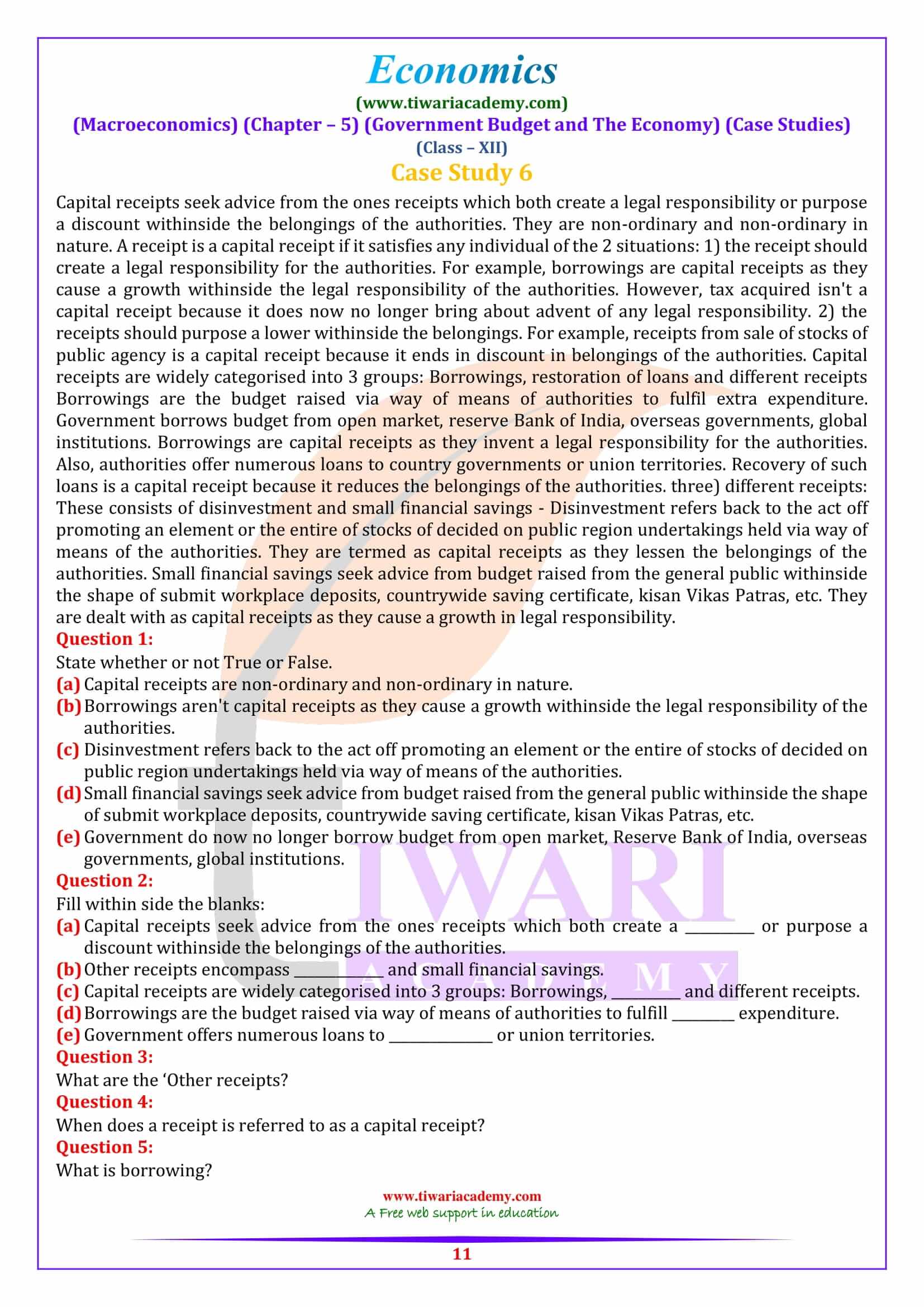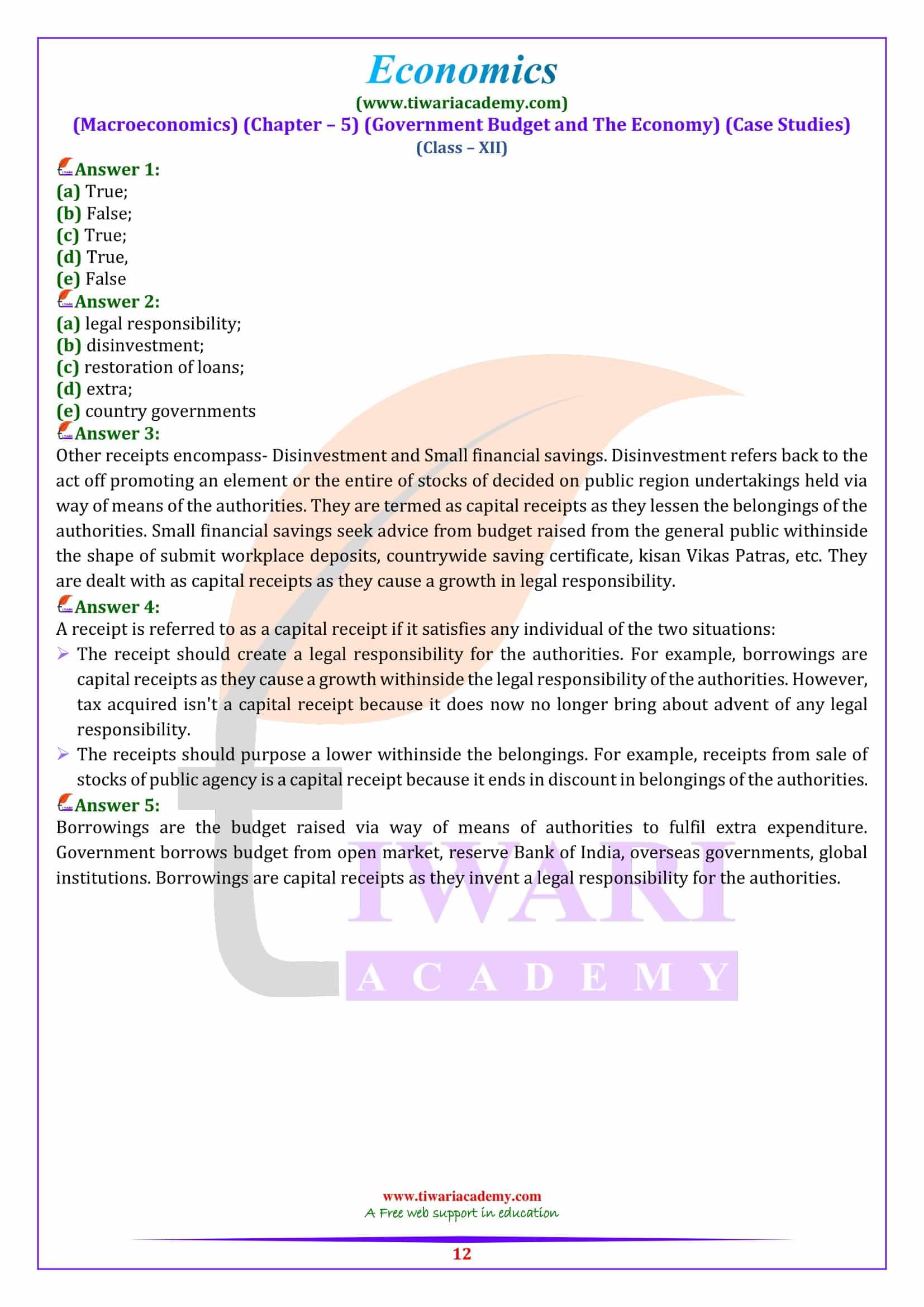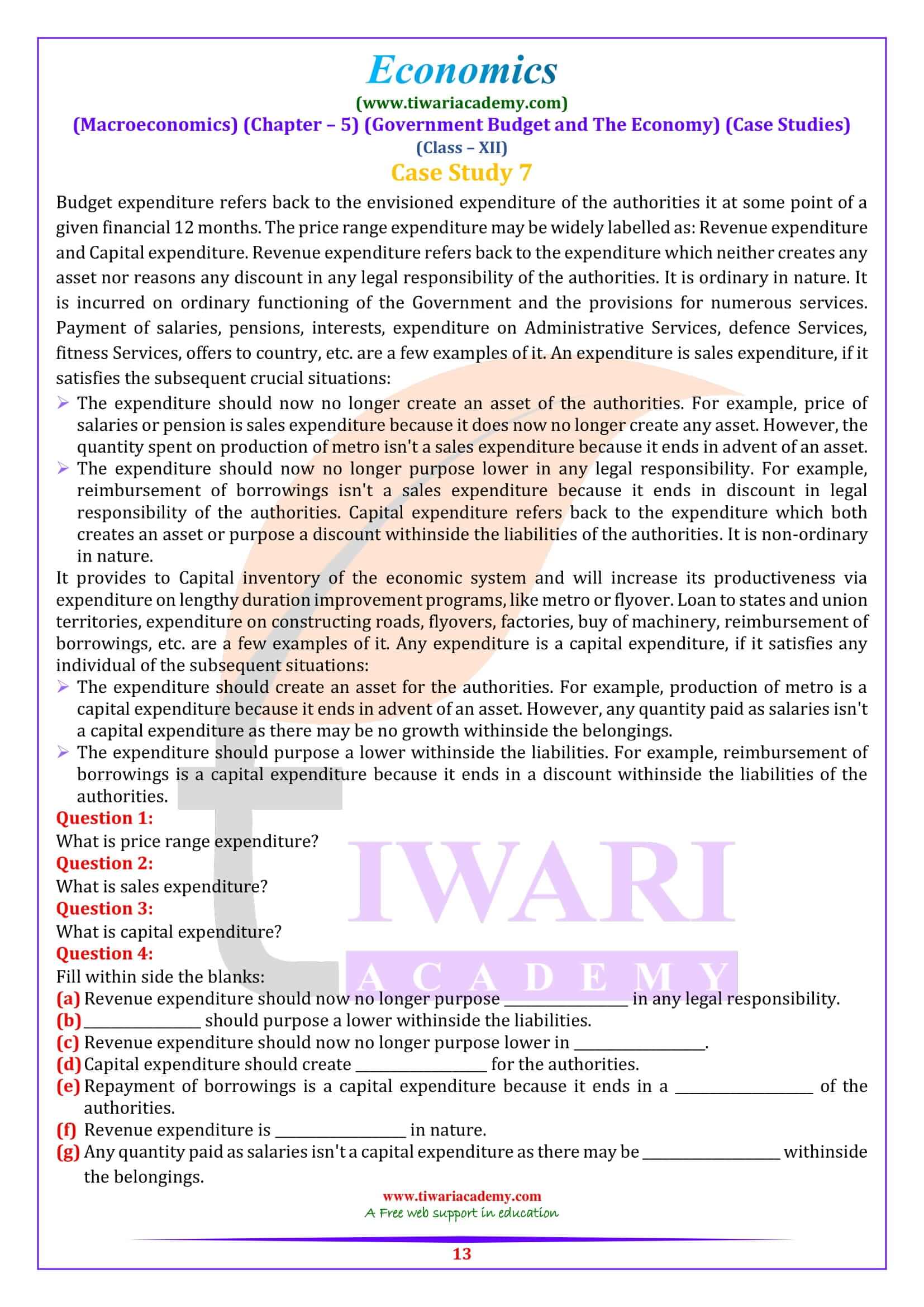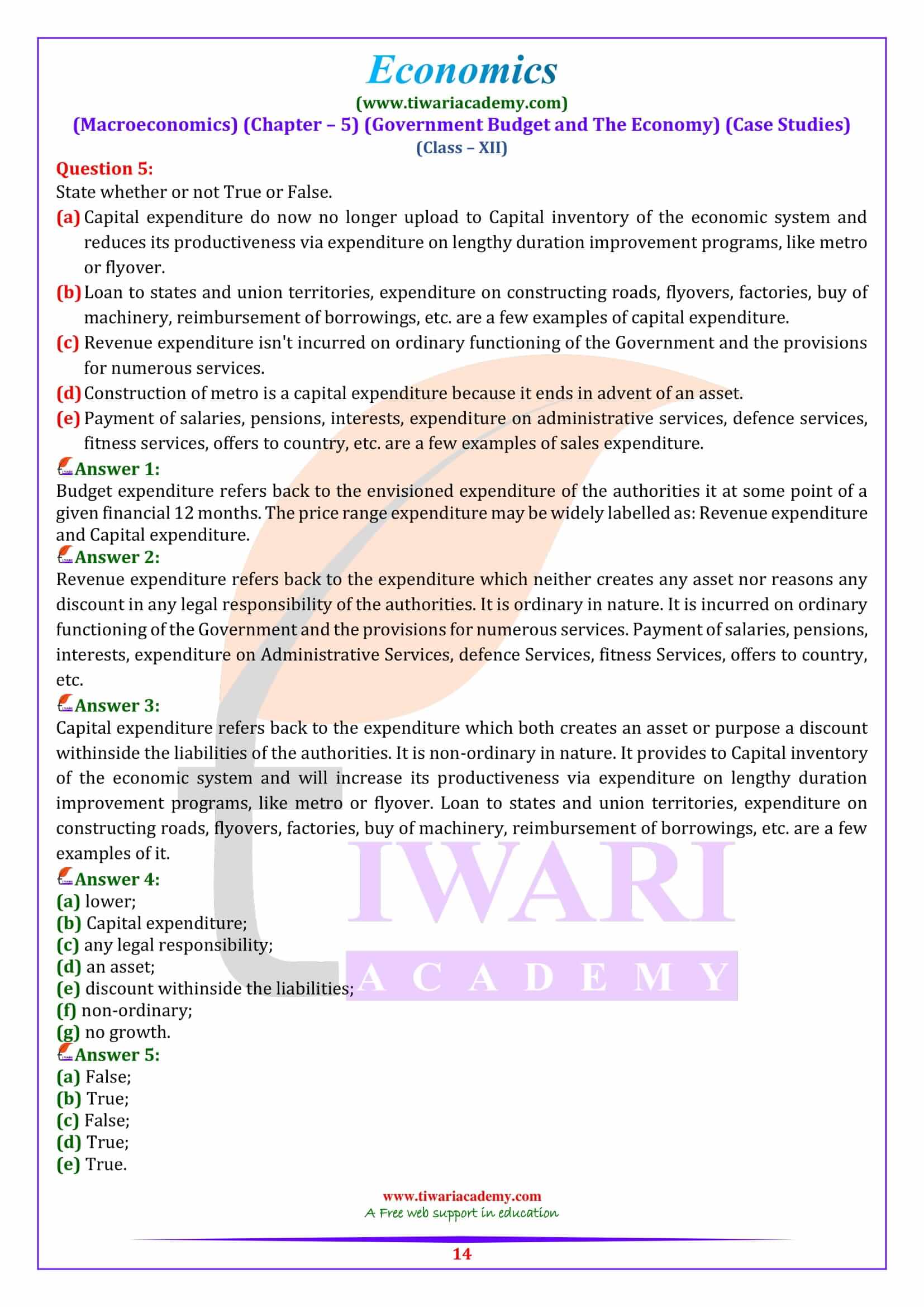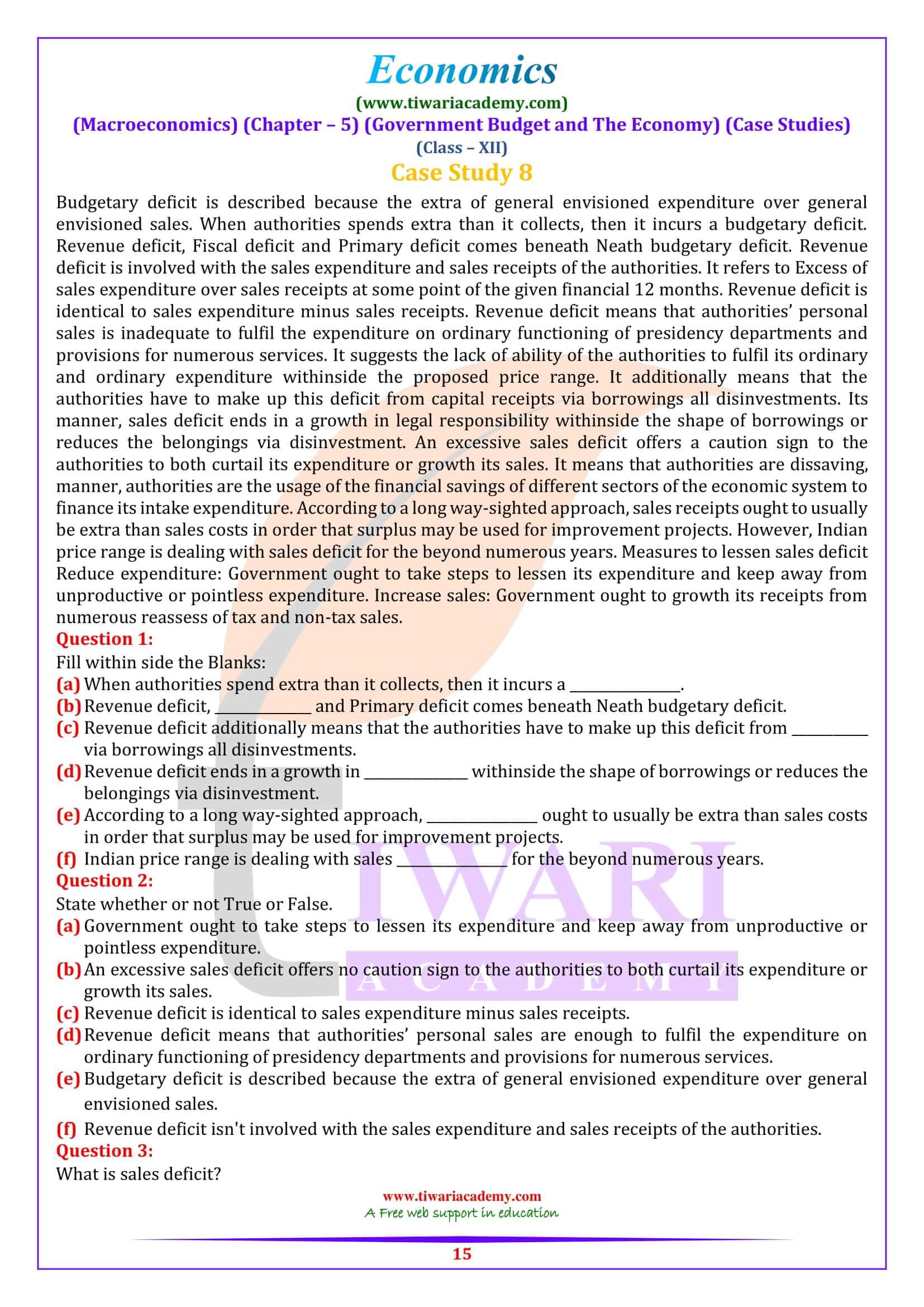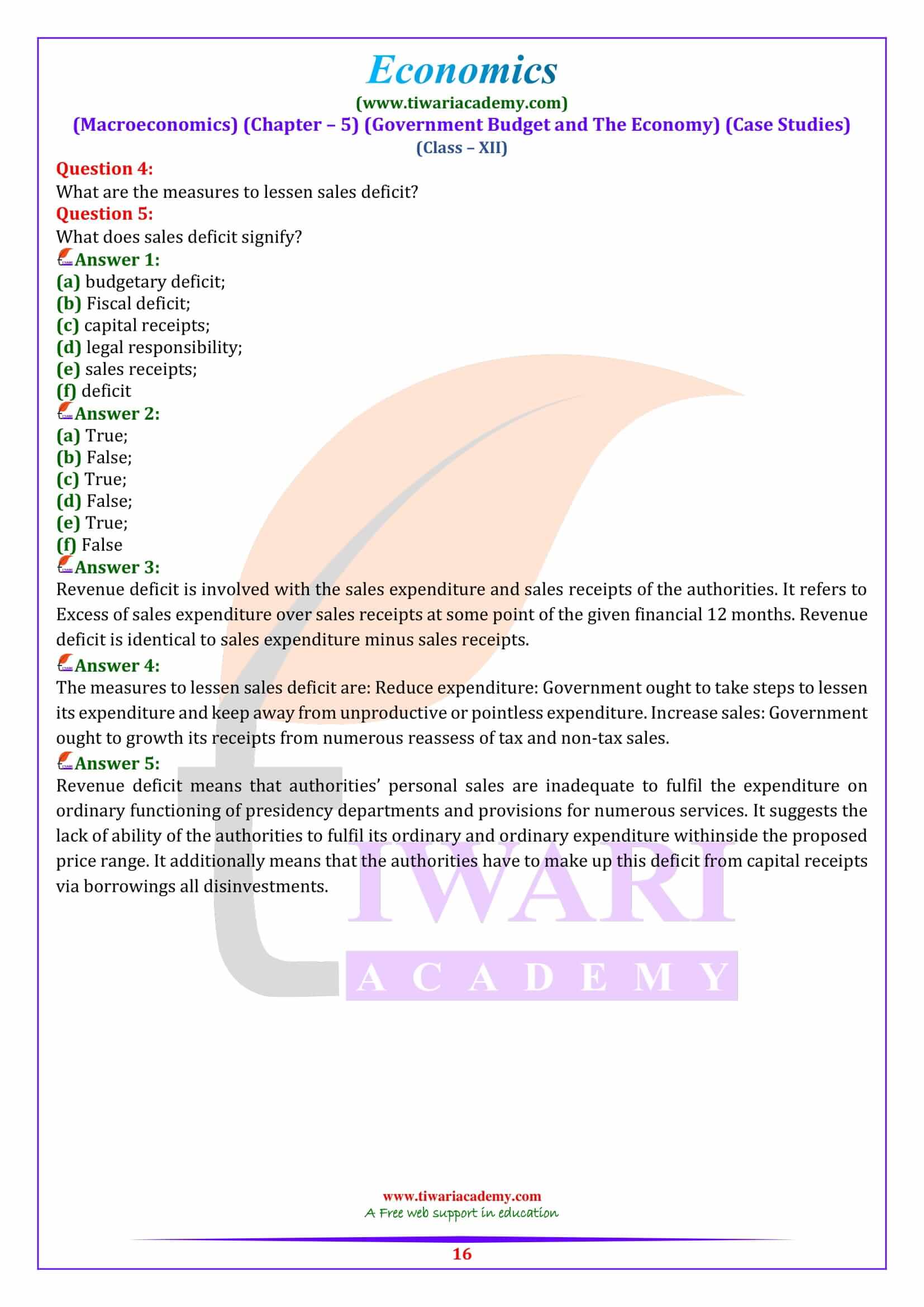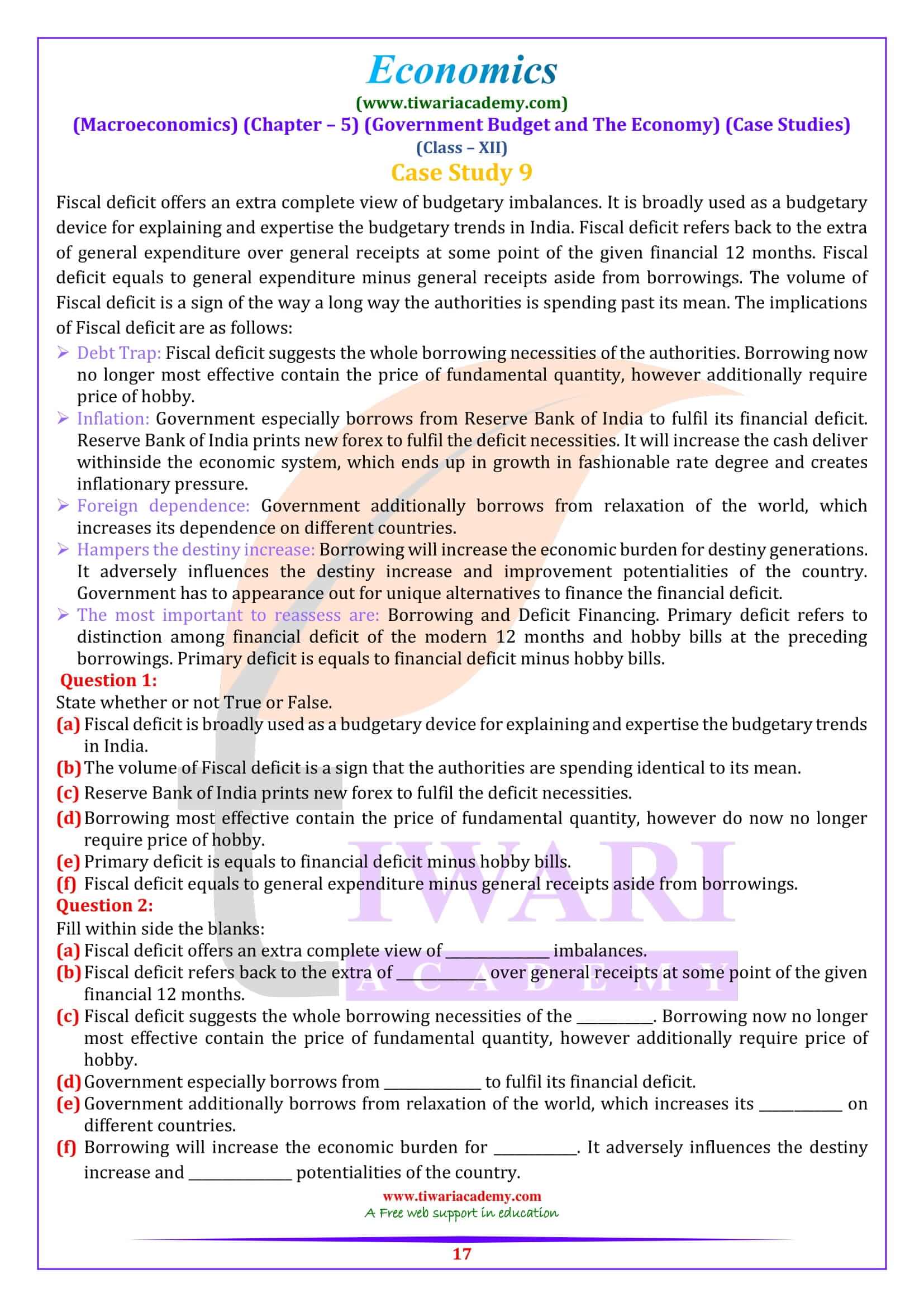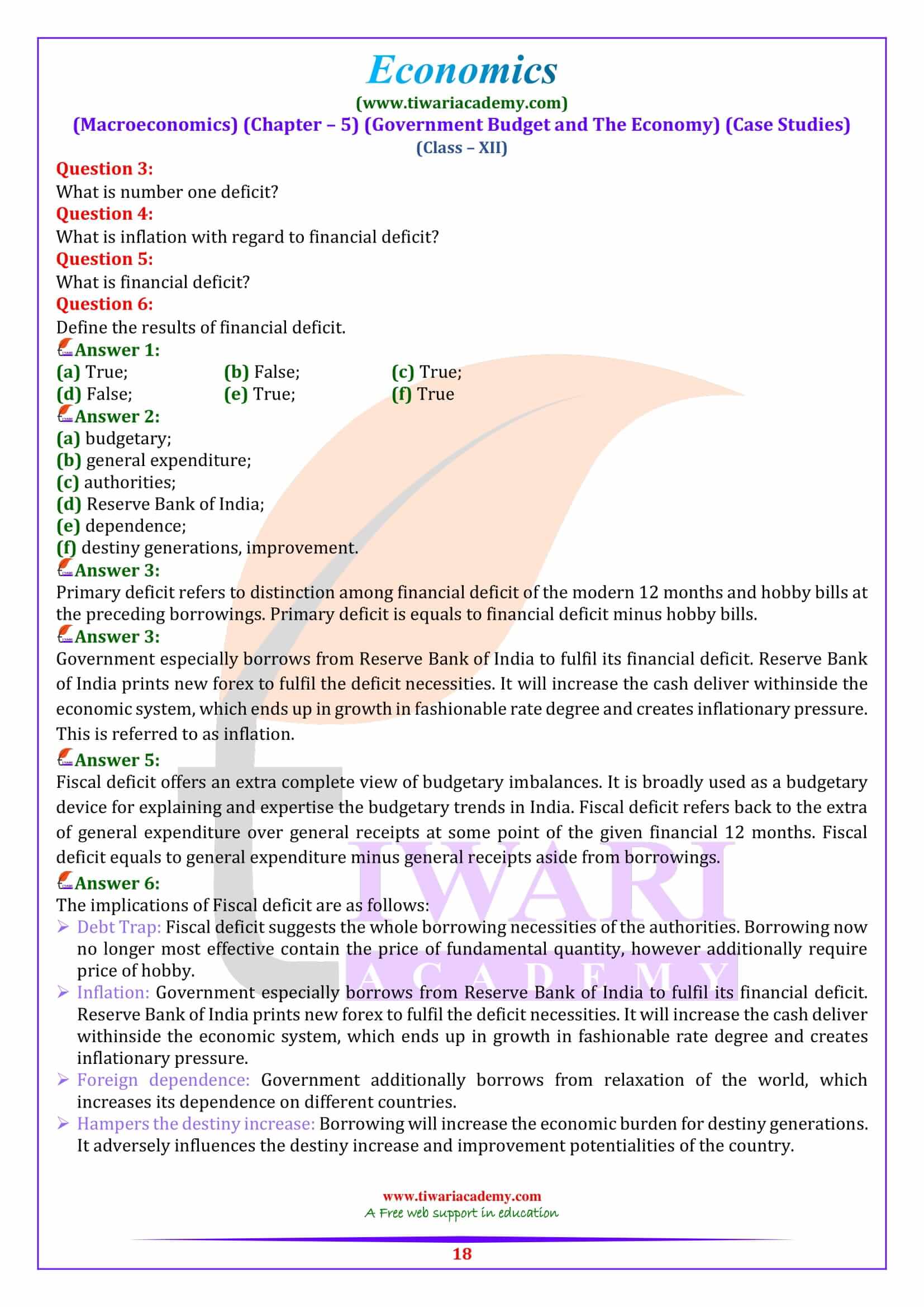NCERT Solutions for Class 12 Macroeconomics Chapter 5 Case Study Questions in English Medium updated for session 2025-26. Case based questions of Class 12 Economics chapter 5 Government Budget and the Economy are given here with Case Study MCQ to get more practice in Case Studies.
Class 12 Macroeconomics Chapter 5 Case Studies Question Answers
Class 12 Macroeconomics Chapter 5 Case Study 1
There is a constitutional requirement in India (Article 112) to provide earlier than the Parliament an assertion of envisioned receipts and costs of the authorities in appreciate of each economic 12 months which runs from 1 April to 31 March. This ‘Annual Financial Statement’ constitutes the principle price range report of the authorities. Although the price range report pertains to the receipts and expenditure of the authorities for a specific economic 12 months, the effect of it is going to be there in next years. Therefore, there may be a want to have accounts- those who relate to the modern economic 12 months most effective are covered within the sales account (additionally referred to as sales price range) and people that problem the belongings and liabilities of the authorities into the capital account (additionally referred to as capital price range).
Budget is ready via way of means of authorities in any respect levels, i.e., vital authorities, country Government and neighbourhood authorities, prepares its respective annual price range. Estimated costs and receipts are deliberate as in step with the goals of the authorities. It is needed to be authorised via way of means of the parliament, earlier than it could be implemented. The price range well-known shows the economic overall performance of the authorities in the remaining 12 months and economic rules for the approaching financial 12 months. In India, price range is supplied inside the parliament on this kind of day, because the President can also additionally direct. By convention, Finance Minister offers the yearly price range of the authorities, on the primary day of February, every 12 months.
- Question 1:
Who offers the yearly price range and whilst? - Question 2:
Fill within side the Blanks:
(a) Estimated costs and receipts are ____________ as in step with the goals of the authorities.
(b) Budget is needed to be authorised via way of means of the ___________, earlier than it could be implemented.
(c) The price range well-known shows the ____________ overall performance of the authorities within the remaining 12 months and economic rules for the approaching financial 12 months.
(d) In India, price range is supplied inside the parliament on this kind of day, because the ____________ can also additionally direct.
(e) Although the price range report pertains to the receipts and expenditure of the authorities for a specific ___________, the effect of it is going to be there in next years. - Question 3:
State whether or not True or False.
(a) The ‘Annual Financial Statement’ constitutes the principle price range report of the authorities.
(b) In India, price range is supplied within the parliament on this kind of day, because the Prime Minister can also additionally direct.
(c) Budget is ready via way of means of authorities in any respect levels, i.e., vital authorities, country Government and neighbourhood authorities, prepares its respective annual price range.
(d) Budget is needed to be authorised via way of means of the President, earlier than it could be implemented. - Question 4:
Why there may be a want to have accounts?
- Answer 1:
By convention, Finance Minister offers the yearly price range of the authorities it on the primary day of February every 12 months. - Answer 2:
(a) deliberate;
(b) parliament;
(c) economic;
(d) President;
(e) economic 12 months
By convention, Prime Minister offers the yearly price range of the authorities, on the primary day of February, every 12 months. - Answer 3:
(a) True;
(b) False;
(c) True;
(d) False;
(e) False - Answer 4:
Although the price range report pertains to the receipts and expenditure of the authorities for a specific economic 12 months, the effect of it is going to be there in next years. Therefore, there may be a want to have accounts: – those who relate to the modern economic 12 months most effective are covered within the sales account (additionally referred to as sales price range) and people that problem the belongings and liabilities of the authorities into the capital account (additionally referred to as capital price range).
Class 12 Macroeconomics Chapter 5 Case Study 2
Government prepares the price range for pleasing positive goals. These goals are the direct final results of presidency’s financial, social and political rules. The numerous goals of presidency price range are:
Reallocation of assets: Through the price range policy, authorities’ pursuits to reallocate assets in according with the financial and social priorities of the country. Government can impact allocation of assets via: (i) Tax concession or subsidies: To inspire investment, authorities can deliver tax concession, subsidies, etc. to the producers. For example, authorities discourage the manufacturing of dangerous intake items via heavy taxes and encourages the usage of khadi merchandise via way of means of imparting subsidies. (ii) Directly generating items and services: There are many non-worthwhile financial sports, which aren’t undertaken via way of means of the personal region like, water deliver, sanitation, regulation and order, countrywide defence, etc. These are referred to as public items. Such sports are always undertaken via way of means of the authorities in public hobby and to elevate social welfare.
Reducing inequalities in profits and wealth: Economic inequality is an inherent a part of each financial system. Government pursuits to lessen such inequalities of profits and wealth, via its budgetary policy. Government pursuits to persuade distribution of profits via way of means of enforcing taxes on wealthy and spending extra at the Welfare of the poor. It will lessen profits of the wealthy and the increase well known of residing of the poor, as a consequence decreasing inequalities inside the distribution of profits. three. Economic balance: Economic balance manner absence of huge-scale fluctuation in costs. Such fluctuations create uncertainties within the economic system. Government can exercising manipulate over those fluctuations via taxes and expenditure. four. Management of public Enterprises: There are huge numbers of public region industries, which might be set up and controlled fall social welfare of the general public. Budget is ready with the goal of creating numerous provisions for handling such Enterprises and imparting them economic assist.
- Question 1:
How the Government can impact allocation of assets? - Question 2:
What is financial balance? - Question 3:
Fill within side the blanks:
(a) Budget is ready with the goal of creating numerous provisions for _______________ such Enterprises and imparting them economic assist.
(b) Government pursuits to lessen such inequalities of ____________, via its budgetary policy.
(c) Government prepares the _______________ for pleasing positive goals.
(d) There are many non-worthwhile financial sports, which aren’t ______________ via way of means of the personal region like, water deliver, sanitation, regulation and order, countrywide defence, etc.
(e) Through the price range policy, authorities’ pursuits to ______________ in according with the financial and social priorities of the country.
(f) Government pursuits to persuade distribution of profits via way of means of ____________ on wealthy and spending extra at the Welfare of the poor. - Question 4:
State whether or not True or False.
(a) Government can deliver down combination call for via way of means of decreasing its personal expenditure.
(b) During deflation, authorities can growth its expenditure and deliver tax concession and subsidies.
(c) Government prepares the price range for pleasing positive goals. These goals aren’t the direct final results of presidency’s financial, social and political rules.
(d) Government can’t exercising manipulate over financial fluctuations via taxes and expenditure.
(e) Budget is ready with the goal of creating numerous provisions for handling such Enterprises and imparting them economic assist.
(f) Government discourages the manufacturing of dangerous intake items via heavy taxes and encourages the usage of khadi merchandise via way of means of imparting subsidies. - Question 5:
How do the authorities lessen inequalities in profits and wealth of an economic system?
- Answer 1:
Government can impact allocation of assets via:
Tax concession or subsidies: To inspire investment, authorities can deliver tax concession, subsidies, etc. to the producers. For example, authorities discourage the manufacturing of dangerous intake items via heavy taxes and encourages the usage of khadi merchandise via way of means of imparting subsidies.
Directly generating items and services: There are many non-worthwhile financial sports, which aren’t undertaken via way of means of the personal region like, water deliver, sanitation, regulation and order, countrywide defence, etc. These are referred to as public items. Such sports are always undertaken via way of means of the authorities in public hobby and to elevate social welfare. - Answer 2:
Economic balance manner absence of huge-scale fluctuation in costs. Such fluctuations create uncertainties within the economic system. Government can exercising manipulate over those fluctuations via taxes and expenditure. - Answer 3:
(a) handling;
(b) profits and wealth;
(c) price range;
(d) undertaken;
(e) reallocate assets;
(f) enforcing taxes - Answer 4:
(a) True;
(b) True;
(c) False;
(d) False;
(e) True;
(f) True - Answer 5:
Economic inequality is an inherent a part of each financial system. Government pursuits to lessen such inequalities of profits and wealth, via its budgetary policy. Government pursuits to persuade distribution of profits via way of means of enforcing taxes on wealthy and spending extra at the Welfare of the poor. It will lessen profits of the wealthy and the increase well known of residing of the poor, as a consequence decreasing inequalities inside the distribution of profits.
Class 12 Macroeconomics Chapter 5 Case Study 3
Components of price range seek advice from shape of the price range. Two most important additives of price range are:
Revenue price range: It offers with the sales issue of the authorities’ price range. It explains how sales is generated or accumulated via way of means of the authorities and the way its miles allotted amongst numerous expenditure heads. Revenue price range has parts: Revenue receipts and sales costs. In short, sales price range is the assertion of envisioned sales receipts and envisioned sales expenditure at some point of a financial 12 months.
Capital price range: It offers with the capital issue of the authority’s price range and it includes: Capital receipts and capital costs. In different words, capital price range is the assertion of envisioned capital receipts and envisioned capital expenditure at some point of a financial 12 months. Budget receipts seek advice from the envisioned cash receipts of the authorities from all reasserts at some point of a given financial 12 months. Budget receipts can be similarly categorised as sales receipts and capital receipts.
The authorities can also additionally want to accurate fluctuations in profits and employment. The standard degree of employment and costs within the economic system relies upon the extent of combination call for which relies upon at the spending selections of hundreds of thousands of personal financial marketers other than the authorities. These selections, in turn, rely on many elements which includes profits and credit score availability. In any duration, the extent of call for might not be enough for complete utilisation of labour and different assets of the economic system. Since wages and costs do now no longer fall under a degree, employment can’t be introduced again to the sooner degree automatically. The authorities’ desires to interfere to elevate the combination call for. On the alternative hand, there can be instances whilst call for exceeds to be had output beneath Neath situations of excessive employment and as a consequence can also additionally deliver upward push to inflation. In such situations, restrictive situations can be had to lessen call for. The intervention of the authorities whether or not to amplify call for or lessen it constitutes the stabilisation function.
- Question 1:
Fill within side the blanks:
(a) The authorities can also additionally want to accurate _________ in profits and employment.
(b) The intervention of the authorities whether or not to _________ call for or lessen it constitutes the stabilisation function.
(c) Budget receipts can be similarly categorised as __________ and capital receipts.
(d) There can be instances whilst call for exceeds to be had output beneath Neath situations of excessive employment and as a consequence can also additionally deliver _________.
(e) Revenue price range offers with the _________ of the authorities’ price range. - Question 2:
State whether or not True or False.
(a) The intervention of the authorities whether or not to amplify call for or lessen it constitutes the stabilisation function.
(b) Revenue price range explains how sales is generated or accumulated via way of means of the authorities and the way its miles allotted amongst numerous expenditure heads.
(c) Revenue price range isn’t the assertion of envisioned sales receipts and envisioned sales expenditure at some point of a financial 12 months.
(d) Budget receipts might not be similarly categorised as sales receipts and capital receipts.
(e) Capital price range is the assertion of envisioned capital receipts and envisioned capital expenditure at some point of a financial 12 months.
(f) Capital price range includes capital receipts and capital costs. - Question 3:
On what does the extent of employment and costs within the economic system relies upon? - Question 4:
What are the additives of price range? - Question 5:
What takes place whilst call for exceeds to be had output? - Question 6:
Complete the subsequent sentence: Budget receipts can be similarly categorised as _______.
- Answer 1:
(a) fluctuations;
(b) amplify;
(c) sales receipts;
(d) upward push to inflation;
(e) sales issue - Answer 2:
(a) True;
(b) True;
(c) False;
(d) False;
(e) True;
(f) True - Answer 3:
The standard degree of employment and costs within the economic system relies upon the extent of combination call for which relies upon at the spending selections of hundreds of thousands of personal financial marketers other than the authorities. These selections, in turn, rely on many elements which includes profits and credit score availability. - Answer 4:
Components of price range seek advice from shape of the price range. Two most important additives of price range are:
Revenue price range: It offers with the sales issue of the authorities’ price range. It explains how sales is generated or accumulated via way of means of the authorities and the way its miles allotted amongst numerous expenditure heads.
Capital price range: It offers with the capital issue of the authorities’ price range and it includes: Capital receipts and capital costs. In different words, capital price range is the assertion of envisioned capital receipts and envisioned capital expenditure at some point of a financial 12 months. - Answer 5:
When call for exceeds to be had output beneath Neath situations of excessive employment, it is able to deliver upward push to inflation. In such situations, restrictive situations can be had to lessen call for. The intervention of the authorities whether or not to amplify call for or lessen it constitutes the stabilisation function. - Answer 6:
Sales receipts and capital receipts.
Class 12 Macroeconomics Chapter 5 Case Study 4
Revenue receipts seek advice from the ones receipts which neither create any legal responsibility nor purpose any discount inside the belongings of the authorities. They are ordinary and ordinary in nature and authorities gets them in its ordinary path of sports. A receipt is a sales receipt, if it satisfies the subsequent crucial situations:
The receipt should now no longer create a legal responsibility for the authorities. For example, taxes levied via way of means of the authorities are sales receipts as they do now no longer create any legal responsibility. However, any quantity, borrowed via way of means of the authorities, isn’t a sales receipt because it reasons a growth within the legal responsibility in phrases of reimbursement of borrowings.
The receipt should now no longer purpose lower inside the belongings. For example, receipts from sale of stocks of a public Enterprise isn’t a sales receipt because it ends in a discount in belongings of the authorities. Revenue receipts of the authorities are usually categorised beneath Neath heads: Tax sales and non-tax sales Tax sales refers to sum general of receipts from taxes and different responsibilities imposed via way of means of the authorities. Tax is a unilateral obligatory price made via way of means of human beings and groups to the authorities without connection with any direct advantage in return. Tax sales may be similarly categorised as: Direct taxes and Indirect taxes.
- Question 1:
What are tax sales? - Question 2:
Fill within side the blanks:
(a) Receipts from sale of stocks of a public Enterprise isn’t a ______ because it ends in a discount in belongings of the authorities.
(b) Taxes levied via way of means of the authorities are sales receipts as they do now no longer create any _________.
(c) Tax sales refers to sum general of receipts from _______ imposed via way of means of the authorities.
(d) Revenue receipts are ordinary and ordinary in nature and authorities gets them in its ______ of sports. - Question 3:
State whether or not True or False.
(a) Tax is a unilateral obligatory price made via way of means of human beings and groups to the authorities without connection with any direct advantage in return.
(b) The sales receipt ought to create a legal responsibility for the authorities.
(c) Receipts from sale of stocks of a public Enterprise isn’t a sales receipt because it ends in a discount in belongings of the authorities.
(d) Taxes levied via way of means of the authorities are sales receipts as they do create a legal responsibility. - Question 4:
When can a receipt be referred to as sales receipt? Explain. - Question 5:
What are sales receipts?
- Answer 1:
Tax sales refers to sum general of receipts from taxes and different responsibilities imposed via way of means of the authorities. Tax is a unilateral obligatory price made via way of means of human beings and groups to the authorities without connection with any direct advantage in return. - Answer 2:
(a) sales receipt;
(b) legal responsibility;
(c) taxes and different responsibilities;
(d) ordinary path. - Answer 3:
(a) True;
(b) False;
(c) True;
(d) False - Answer 4:
A receipt is a sales receipt, if it satisfies the subsequent crucial situations: i) The receipt should now no longer create a legal responsibility for the authorities. For example, taxes levied via way of means of the authorities are sales receipts as they do now no longer create any legal responsibility. However, any quantity, borrowed via way of means of the authorities, isn’t a sales receipt because it reasons a growth within the legal responsibility in phrases of reimbursement of borrowings. ii) The receipt should now no longer purpose lower inside the belongings. For example, receipts from sale of stocks of a public Enterprise isn’t a sales receipt because it ends in a discount in belongings of the authorities. - Answer 5:
Revenue receipts seek advice from the ones receipts which neither create any legal responsibility nor purpose any discount within the belongings of the authorities. They are ordinary and ordinary in nature and authorities gets them in its ordinary path of sports.
Class 12 Macroeconomics Chapter 5 Case Study 5
Direct taxes seek advice from taxes which are imposed on belongings and profits of people and groups and their burden can’t be shifted to the alternative character. They are imposed on people and groups and their financial burden is borne via way of means of the ones on whom they’re levied. The ‘legal responsibility to pay’ the tax and real burden of the tax lie at the equal position, manner, its burden can’t be shifted to others. They immediately have an effect on the profits degree and buying energy of human beings and assist to alternate the extent of combination call for within the economic system. Examples of direct tax are: Income tax, company tax, hobby tax, wealth tax, dying duty, capital profits tax, etc.
Indirect taxes are the ones taxes which may be shifted to some other character. Their financial burden is in the long run borne via way of means of very last customers of products and services, instead of the character on whom the tax is levied. Indirect taxes all imposed on items and services. The ‘legal responsibility to pay’ the tax and ‘real burden’ of the tax lie on unique persons, manner, its burden may be shifted to others. Examples of oblique taxes are: GST, primary custom duty, vital excise and VAT on petroleum merchandise, excise on liquor, energy responsibilities, stamp duty, securities transaction tax, belongings tax, access taxes and toll, etc. Indirect taxes are obligatory bills however they may be prevented via way of means of now no longer getting into the one’s transactions, which name for such taxes. For example, customers can also additionally store taxes via way of means of buying Khadi Gram Udyog objects as there may be no oblique tax on Khadi objects.
- Question 1:
What are oblique taxes? - Question 2:
State whether or not True or False.
(a) Indirect taxes are obligatory bills however they may be prevented via way of means of now no longer getting into the ones transactions, which name for such taxes.
(b) Examples of oblique taxes are: GST, primary custom duty, vital excise and VAT on petroleum merchandise, excise on liquor, energy responsibilities, stamp duty, securities transaction tax, belongings tax, access taxes and toll, etc.
(c) Direct taxes aren’t imposed on people and groups and their financial burden isn’t borne via way of means of the ones on whom they’re levied.
(d) Consumers can also additionally store taxes via way of means of buying Khadi Gram Udyog objects as there may be no oblique tax on Khadi objects.
(e) Direct taxes in a roundabout way have an effect on the profits degree and buying energy of human beings and assist to alternate the extent of combination call for inside the economic system. - Question 3:
Fill within side the blanks:
(a) The ‘legal responsibility to pay’ the tax and ‘real burden’ of the tax lie on unique persons, manner, its burden may be _________ to others.
(b) The ‘legal responsibility to pay’ the tax and ________ of the tax lie at the equal position, manner, its burden can’t be shifted to others.
(c) Direct taxes immediately have an effect on the profits degree and __________ of human beings and assist to alternate the extent of combination call for within the economic system.
(d) Indirect taxes are obligatory bills however they may be ________ via way of means of now no longer getting into the ones transactions, which name for such taxes.
(e) The financial burden of oblique taxes is in the long run borne via way of means of _______ of products and services, instead of the character on whom the tax is levied. - Question 4:
What are direct taxes? - Question 5:
What are the variations among direct taxes and oblique taxes?
- Answer 1:
Indirect taxes are the ones taxes which may be shifted to some other character. Their financial burden is in the long run borne via way of means of very last customers of products and services, instead of the character on whom the tax is levied. Indirect taxes all imposed on items and services. - Answer 2:
(a) True;
(b) True;
(c) False;
(d) True;
(e) False - Answer 3:
(a) shifted;
(b) real burden;
(c) buying energy;
(d) prevented;
(e) very last customers - Answer 4:
Direct taxes seek advice from taxes which are imposed on belongings and profits of people and groups and their burden can’t be shifted to the alternative character. They are imposed on people and groups and their financial burden is borne via way of means of the ones on whom they’re levied. - Answer 5:
Direct taxes levied on people and groups. The burden of an instantaneous tax can’t be shifted and they’re usually modern in nature. They have confined attain as they do now no longer attain the all of the sections of the economic system. Indirect taxes are levied on items and services. The burden of an oblique tax may be shifted and they’re usually proportional in nature. They have an extensive insurance as they attain all of the sections of the society.
